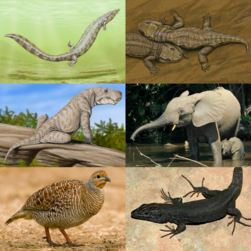Reptiliomorpha
Reptiliomorpha (berarti "berbentuk mirip reptil"; dalam PhyloCode sebagai Pan-Amniota[2][3]) adalah sebuah klad yang mencakup amniota dan tetrapoda-tetrapoda yang memliki nenek moyang bersama yang lebih muda dengan amniota daripada dengan amfibi hidup (Lissamphibia). Klad ini didefinisikan oleh Michael Laurin (2001) dan Vallen dan Laurin (2004) sebagai klad terbesar yang mencakup Homo sapiens, namun tidak mencakup Ascaphus truei (katak berekor).[4][5] Laurin dan Reisz (2020) mendefinisikan Pan-Amniota sebagai klad total terbesar yang mencakup Homo sapiens, namun tidak mencakup Pipa pipa, Caecilia tentaculata, dan Siren lacertina.[2][3]
| Reptiliomorpha | |
|---|---|
 | |
| Keanekaragaman klad reptiliomorpha.
1st row (kelompok batang): Archeria crassidica, Seymouria sanjuanensis; 2nd row (Synapsida): Dinogorgon rubidgei, Loxodonta cyclotis; 3rd row (Sauropsida/Reptilia): Ortygornis pondicerianus, Podarcis muralis. | |
| Klasifikasi ilmiah | |
| Domain: | Eukaryota |
| Kerajaan: | Animalia |
| Filum: | Chordata |
| Superkelas: | Tetrapoda |
| Klad: | Reptiliomorpha Säve-Söderbergh, 1934 |
| Subkelompok | |
| |
| Sinonim | |
|
Pan-Amniota Rowe, 2004[1] | |
Referensi
sunting- ^ Rowe, T. (2004). "Chordate phylogeny and development". Assembling the Tree of Life. J. Cracraft and M. J. Donoghue, eds. Oxford: Oxford University Press. hlm. 384–409. ISBN 0-19-517234-5.
- ^ a b de Queiroz, K.; Cantino, P. D.; Gauthier, J. A., ed. (2020). "Pan-Amniota T. Rowe 2004 [M. Laurin and T. R. Smithson], converted clade name". Phylonyms: A Companion to the PhyloCode. Boca Raton: CRC Press. hlm. 789–792. ISBN 978-1-138-33293-5.
- ^ a b "Pan-Amniota". RegNum.
- ^ Laurin, M. (2001). "L'utilisation de la taxonomie phylogénétique en paléontologie: avantages et inconvénients". Biosystema. 19: 197–211.
- ^ Vallin, Grégoire; Laurin, Michel (2004). "Cranial morphology and affinities of Microbrachis, and a reappraisal of the phylogeny and lifestyle of the first amphibians". Journal of Vertebrate Paleontology. 24 (1): 56–72. doi:10.1671/5.1.